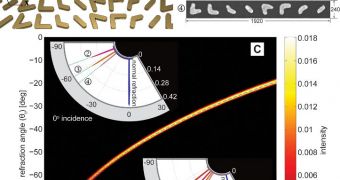A group of investigators from the Purdue University announce the development of specialized arrays capable of controlling light. The instruments can manipulate photons in very specific ways, potentially enabling a new generation of computers, microscopes and telecommunications devices.
The arrays are made up of very small plasmonic nanoantennas, devices that can easily change the phase of light. This characteristic defines the high and low points of the wavelength at which a particular stream of photons is traveling.
The best way to think of this is to compare the way light travels with the way waves propagate through water. If the phase of light is changed abruptly, then the way it propagates can also be controlled. This is precisely what the Purdue team was able to accomplish.
“By abruptly changing the phase we can dramatically modify how light propagates, and that opens up the possibility of many potential applications,” says distinguished professor of electrical and computer engineering Vladimir Shalaev.
The expert is also the scientific director of nanophotonics at the Purdue Birck Nanotechnology Center. Details of the work he and his team carried out are published in the December 22 issue of the top journal Science.
The study was an improvement on a previous work by experts at the Harvard University, which provided new insights into Snell's law. This essential law of physics has been used for many years to describe the way in which light reflects or refracts along the surface of a material.
One of its many ideas was that no abrupt phase changes occur at this interface, but the Harvard team showed that this principle can be invalidated by the use of metamaterials. These are entirely-artificial constructs, designed specifically to manipulate light.
When the surface of an object is coated with metamaterials, light begins to behave weirdly. Purdue researchers showed that there are some patterns in this strange behavior, and also that the patterns can be controlled and used for practical applications.
“We have extended the Harvard team's applications to the near infrared, which is important, and we also showed that it's not a single frequency effect, it's a very broadband effect. Having a broadband effect potentially offers a range of technological applications,” Shalaev explains.
“Importantly, such dramatic deviation from the conventional Snell's law governing reflection and refraction occurs when light passes through structures that are actually much thinner than the width of the light's wavelengths, which is not possible using natural materials,” the expert adds.
“Also, not only the bending effect, refraction, but also the reflection of light can be dramatically modified by the antenna arrays on the interface, as the experiments showed,” Shalev concludes.

 14 DAY TRIAL //
14 DAY TRIAL //